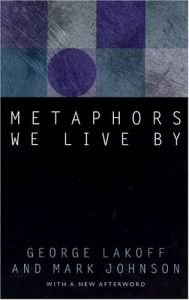 Zusammenfassungen
Zusammenfassungen
 The now-classic Metaphors We Live By changed our understanding of metaphor and its role in language and the mind. Metaphor, the authors explain, is a fundamental mechanism of mind, one that allows us to use what we know about our physical and social experience to provide understanding of countless other subjects. Because such metaphors structure our most basic understandings of our experience, they are "metaphors we live by&quo.
The now-classic Metaphors We Live By changed our understanding of metaphor and its role in language and the mind. Metaphor, the authors explain, is a fundamental mechanism of mind, one that allows us to use what we know about our physical and social experience to provide understanding of countless other subjects. Because such metaphors structure our most basic understandings of our experience, they are "metaphors we live by&quo. Dieses Buch erwähnt ...
Dieses Buch erwähnt ...
 Zitationsgraph
Zitationsgraph
 Zitationsgraph (Beta-Test mit vis.js)
Zitationsgraph (Beta-Test mit vis.js)
 Zeitleiste
Zeitleiste
 25 Erwähnungen
25 Erwähnungen 
- Images of Organization (Gareth Morgan) (1986)

- The Language of Graphics - A framework for the analysis of syntax and meaning in maps, charts and diagrams (Jörg von Engelhardt) (2002)


- The Emotion Machine - Commonsense Thinking, Artificial Intelligence, and the Future of the Human Mind (Marvin Minsky) (2006)

- How the Body Shapes the Way We Think - A New View of Intelligence (Rolf Pfeifer, Josh Bongard) (2006)

- Intuitive Modelle der Informatik (Michael Weigend) (2007)


- Software Studies - A Lexicon (Matthew Fuller) (2008)

- Das Container-Prinzip - Wie eine Box unser Denken verändert (Alexander Klose) (2009)

- Enaction, Embodiment, Evolutionary Robotics - Simulation Models for a Post-Cognitivist Science of Mind (Markus Rohde) (2010)

- The Future of Educational Neuroscience (Kurt W. Fischer, Usha Goswami, John Geake, Task Force on the Future of Educational Neuroscience) (2010)


- Wie Jugendliche schreiben - Schreibkompetenz und neue Medien (Christa Dürscheid, Franc Wagner, Sarah Brommer) (2010)

- The Semantic Sphere - Computation, Cognition and Information Economy (Pierre Lévy) (2011)


- Bildung im Netz - Analyse und bildungstheoretische Interpretation der neuen kollaborativen Praktiken in offenen Online-Communities (Christoph Jan Koenig) (2011)


- Die Analogie - Das Herz des Denkens (Douglas Hofstadter, Emmanuel Sander) (2013)

- How Humans Learn to Think Mathematically - Exploring the Three Worlds of Mathematics (David Tall) (2013)

- The container principle - how a box changes the way we think (Alexander Klose) (2015)

- Thinking with Diagrams - The Semiotic Basis of Human Cognition (Sybille Krämer, Christina Ljungberg) (2016)

- Coding Literacy - How Computer Programming Is Changing Writing (Annette Vee) (2017)

- Art education in the post-digital era - Experiential construction of knowledge through creative coding (Tomi Slotte Dufva) (2018)


- ICER 2018 - Proceedings of the 2018 ACM Conference on International Computing Education Research, ICER 2018, Espoo, Finland, August 13-15, 2018 (Lauri Malmi, Ari Korhonen, Robert McCartney, Andrew Petersen) (2018)
- Applying a Gesture Taxonomy to Introductory Computing Concepts (Amber Solomon, Mark Guzdial, Betsy DiSalvo, Ben Rydal Shapiro) (2018)


- Applying a Gesture Taxonomy to Introductory Computing Concepts (Amber Solomon, Mark Guzdial, Betsy DiSalvo, Ben Rydal Shapiro) (2018)
- Team Human (Douglas Rushkoff) (2019)

- Schule, Digitalität & Schreiben - Impulse für einen souveränen Deutschunterricht (Michael Rödel) (2020)

- Lernsituationen mit Metaphern und Wikibooks - Fallstudien zu Entwicklungspotenzialen einer integrativen Medienbildung in der Lehrerinnen- und Lehrerbildung (2020)


- Datengetriebene Schule - Forschungsperspektiven im Anschluss an den 27. Kongress der DGfE (Mandy Schiefner, Sandra Hofhues, Andreas Breiter) (2021)
- «... dass man denen auch mal 'nen Spiegel vorhalten kann» - Metaphern im Diskurs um Daten (in) der Schule (Michael Becker, Ulrike Krein, Mandy Schiefner)


- «... dass man denen auch mal 'nen Spiegel vorhalten kann» - Metaphern im Diskurs um Daten (in) der Schule (Michael Becker, Ulrike Krein, Mandy Schiefner)
- Metaphors of Ed Tech (Martin Weller) (2022)


- Resisting Dehumanization in the Age of «AI» (Emily M. Bender) (2024)


 Co-zitierte Bücher
Co-zitierte Bücher

Der mittlere Weg der Erkenntnis
Der Brückenschlag zwischen wissenschaftlicher Theorie und menschlicher Erfahrung
The Embodied Mind
(Francisco J. Varela, Evan Thompson, Eleanor Rosch) (1991)





Notes on the Synthesis of Form
(Christopher Alexander) (1964)
 Volltext dieses Dokuments
Volltext dieses Dokuments
 Bibliographisches
Bibliographisches 
 Beat und dieses Buch
Beat und dieses Buch
Beat hat dieses Buch während seiner Zeit am Institut für Medien und Schule (IMS) ins Biblionetz aufgenommen. Beat besitzt kein physisches, aber ein digitales Exemplar. (das er aber aus Urheberrechtsgründen nicht einfach weitergeben darf). Aufgrund der wenigen Einträge im Biblionetz scheint er es nicht wirklich gelesen zu haben.











 Inflation
Inflation Sprache
Sprache



















 , 987 kByte)
, 987 kByte) 


 Biblionetz-History
Biblionetz-History